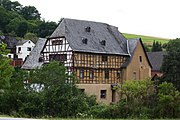
Limburg an der Lahn is the district seat of Limburg-Weilburg in Hesse, Germany.

Katzenelnbogen is the name of a castle and small town in the district of Rhein-Lahn-Kreis in Rhineland-Palatinate, Germany. Katzenelnbogen is the seat of the Verbandsgemeinde Aar-Einrich.

Sankt Goarshausen is a town located in the Rhein-Lahn-Kreis in Nassau on the eastern shore of the Rhine, in the section known as the Rhine Gorge, directly across the river from Sankt Goar, in the German state Rhineland-Palatinate. It is located within the Nassau Nature Park and the Rhine Gorge UNESCO world heritage site, and was historically part of the Duchy of Nassau. It lies approximately 30 km south of Koblenz, and it is above all famous for the Lorelei rock nearby. Sankt Goarshausen is the seat of the Loreley collective municipality. The town's economy is based on wine making and tourism.
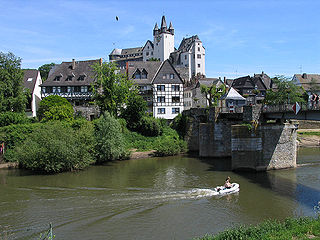
Diez an der Lahn is a town in Germany's Rhein-Lahn district in Rhineland-Palatinate, on the borders of Hesse. Diez is the administrative seat of the municipality of Diez.

Braunfels is a town in the Lahn-Dill-Kreis in Hesse, Germany. It is located on the German Timber-Frame Road.

Cramberg is a municipality in the Nassau Nature Park in the district of Rhein-Lahn, in Rhineland-Palatinate, in western Germany. It belongs to the Verbandsgemeinde of Diez.

Seck is an Ortsgemeinde – a community belonging to a Verbandsgemeinde – in the Westerwaldkreis in Rhineland-Palatinate, Germany.

Altencelle is part of the borough of Celle in Lower Saxony and lies southeast of the town centre, west of the River Aller and east of the Fuhse. It is linked to Celle by the B 214 federal road and state highway K 74.
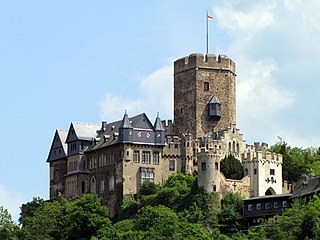
Lahneck Castle is a medieval fortress located in the city of Lahnstein in Rhineland-Palatinate, Germany, south of Koblenz. The 13th-century castle stands on a steep rock salient above the confluence of the Lahn River with the Rhine, opposite Stolzenfels Castle, in the district of Oberlahnstein. Its symmetrical plan, an oblong rectangle, is typical of the later castles of the time of the Hohenstaufen. The pentagonal shape of the bergfried is rare for castle towers.

The Alte Burg is a ruined spur castle that only comprises half a bergfried and is located in the Lower Saxon district of Osterode in the Harz Mountains of central Germany. The name means "Old Castle".

Runkel Castle, a ruined hill castle from the High Middle Ages, is located in the city of Runkel in the Landkreis of Limburg-Weilburg in the state of Hesse.

Greifenstein Castle lies in the eponymous village of Greifenstein in the county of Lahn-Dill-Kreis in Middle Hesse, Germany. It is a geo point in the national geopark of Westerwald-Lahn-Taunus.
Alte Burg, Alteburg or Burgstall Alte Burg refers to the name or nickname of various castles, castle ruins, castle sites and hillforts or ringworks:

The Alte Burg in Bad Münstereifel, Germany, is a circular rampart that is the remains of a fortification from the Carolingian period. The refuge castle acted as a place of retreat for the local population and as protection for the daughter monastery of Prüm Abbey. The defences dating to the 9th century have been designated as a protected monument. The castle site lies within the county of Euskirchen in the state of North Rhine-Westphalia.
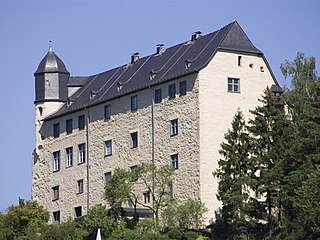
Schadeck Castle is a counter-castle which was built in opposition to the nearby Runkel Castle. It stands above the River Lahn in the eponymous parish in the county of Limburg-Weilburg in the German state of Hesse.

A coercion castle or coercive castle was a heavily fortified, medieval castle built to dominate the surrounding land. Such castles were built mainly in the High and Late Middle Ages in order to protect those territories in areas where the population was not assessed as being entirely loyal to the sovereign. Because of the poor infrastructure of medieval Europe, the construction of castles was one of the most important ways of exercising power, which is why it was governed by royal rights. Examples of coercive castles are the Moritzburg in Halle, which was built in the late 15th century, and the Alte Burg in Koblenz.

The Old Castle was a former Elector-owned, substantial water castle in the German city of Koblenz, incepted in the 13th century. It is today reduced to the later Burghaus ; which houses the city archives. It sits on tall foundations and has a tall, black slate roof with further floors in the attic and two small cupolas. The lowland castle abutted the remaining building in the old town quarter. The castle house stands tall, next to the Moselle's right-bank towpath downstream of the strategic Baldwin Bridge built in 1342. The bridge, much-repaired, remains intact.

Waldmannshausen Castle is a water castle built from 1486 to 1488 by Thebus of Waldmannshausen in the village of Elbgrund in the municipality of Elbtal) in the county of Limburg-Weilburg in the German state of Hesse. It is located about 18 kilometres north of the town of Limburg an der Lahn. The castle was once a single unit with the neighbouring estate of Waldmannshausen. On the land of the estate is another, ruined, water castle, the Alte Burg. The property is on the edge of the municipality on the road to Frickhofen. The castle and its associated schloss, built in 1790, have been used as a Schullandheim - a country educational facility used to enhance normal schools - since 1935. The castle is owned by Schullandheim Burg Waldmannshausen;; with its headquarters in Westphalian Hagen.
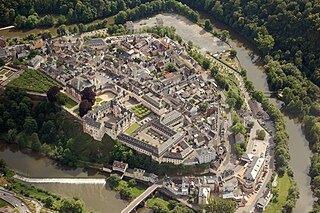
Schloss Weilburg is a Baroque schloss in Weilburg, Hesse, Germany. It is located on a spur above the river Lahn and occupies about half of the area of the Old Town of Weilburg. It contains the Hochschloss, built between 1530 and 1572, which is one of the best-preserved Renaissance palaces in Hesse. In the 1700s, the palace was expanded by John Ernst, Count of Nassau-Weilburg, and his builder, Julius Ludwig Rothweil. The buildings and gardens now belong to the Verwaltung der Staatlichen Schlösser und Gärten Hessen, and they can be visited as a museum on guided tours. Parts of the palace are venues for the music festival Weilburger Schlosskonzerte, which is named after the palace.



